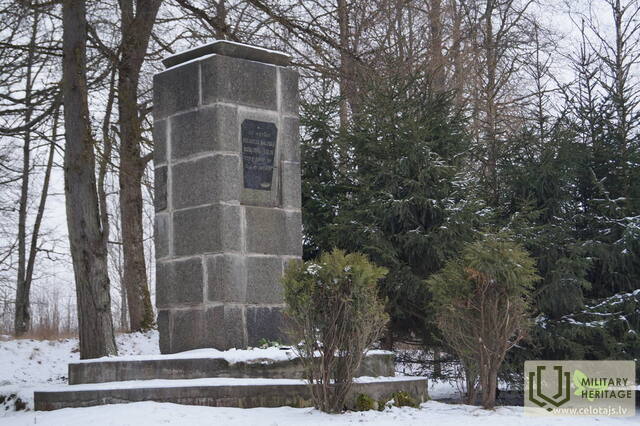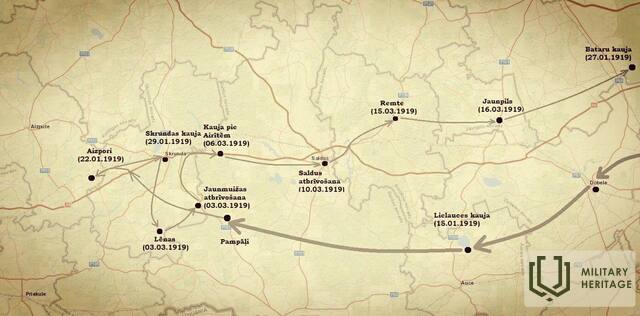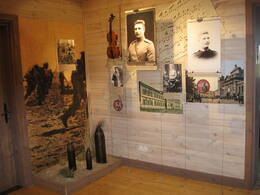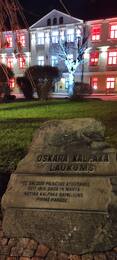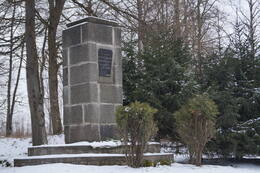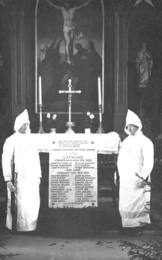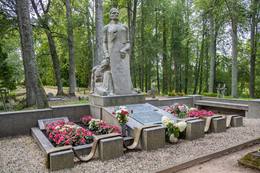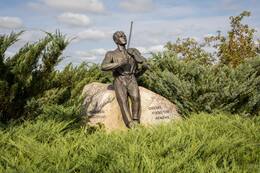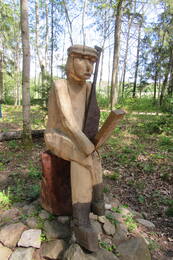The Battle of the Oskars Kalpaks Battalion at Lielauce
On the night of January 15, the Kalpaks Battalion fought the first battle at Lielauce, repelling the Red attack. It was the first significant battle of the Kalpaks Battalion, and the victory gave the soldiers a particularly strong morale boost.
The Kalpaks battalion stayed in Lielauce for only three days in the distant 1919, but this battle has remained a very significant moment in the history of Latvia. “The military forces were small, part of the Latvian army was part of the German army when the Red Army entered Latvia with a huge advantage. Thanks to the careful work of the scouts, this battle was short but bloody, which began after midnight, allowing both sides to make mistakes - the “reds”, seeing the lights left by the Kalpaks battalion on the 2nd floor of the castle, were able to identify the target of the attack, but two, - soldiers stationed further towards Dobele, noticed the attackers, although there was a deep blizzard and the rocket gun did not work either, running away and giving the correct warning, the battle had no surprise background. The first to fall was Lieutenant Pēteris Dambītis, because he had left his soldier's boots next to him at the post, so he did not have time to put them on... The Kalpaks battalion was not defeated due to the incompetence of the "reds", because the superiority was three times greater - the soldiers who attacked did not notice that the water in the machine gun barrel had frozen, which also helped win this battle (..). This is how Major Ilgvars Baumanis, the head of the Latvian National Guard Veterans Association, spoke about Kalpaks' first battle at the memorial ceremony in Lielauce (~ in 2015).
Auce County Tourist Information Center, 30.09.2016
Related objects
Oskars Kalpaks Museum and Memorial Site “Airītes”
The Oskars Kalpaks Museum and Memorial Site Airītes is located between Saldus and Skrunda near the A9 highway. The exhibit has extensive information about Colonel Oskars Kalpaks and his battalion, and shows the history of the Latvian National Army and the memorial site Airītes. The exhibit reveals Colonel Oskars Kalpaks as a personality, as a soldier and as a fighter for Latvia's independence. Audio logs in Latvian, English and German are also available as part of the exhibit. They emphasize the importance of the historic events of 1918/1919 in the protecting the statehood of Latvia. The museum building has been restored.
Entry is free; guided tour – for a fee. The complex has a recreation area, a park, an obstacle course, it is possible to take various classes, and there is a seminar hall for up to 30 people.
Memorial stone in Oskaras Kalpaka Square in Saldus
O.Kalpaka Square is located in the very centre of Saldus, at the intersection of Lielā and Striķu streets.
The former market square is today a favourite place of recreation for residents and visitors of Saldus, where concerts, commemorative events and festivities are held. On 10 March 1919, Saldus became the first Latvian town liberated by Colonel Oskars Kalpaks' battalion.
On 14 March 1919, the first parade of the Latvian Separate Battalion took place in the square, and in 1992, in honour of Colonel Kalpakas, the square was named after him.
A Monument Dedicated to the First Battle of Oskar Kalpak’s Battalion in Lielauce
A monument dedicated to the first battle of Oskar Kalpak’s battalion is situated next to the ruins of Lielauce Lutheran Church. It was erected at the site of the battle of Kalpak’s battalion, which took place on the night of 15 to 16 January 1919. In the battle, two companies of Kalpak’s battalion repelled an attack by an entire Bolshevik battalion and a squadron of cavalry. It was the first important battle of Kalpak’s battalion. As the Landeswehr lost the battle in Auce, the decision was made to retreat and hold the front at a natural obstacle – the River Venta.
The monument was unveiled on 19 August 1934 in the presence of the former fighter of the battalion, Minister of Agriculture, J. Kauliņš. The monument was designed by an architect P. Dreimanis and manufactured by J. Sieriņš. The monument is made of grey granite blocks, with a black granite plaque at the front with the following inscription: “The battle of Colonel Kalpak’s battalion took place here on the night from 15 to 16 January 1919.” Four soldiers were killed in action.
The monument was destroyed in the early 1950s and the plaque was smashed. It was restored in 1991 by using the original plaque, which had been split in two. In the restored monument, the plaque no longer faces the church, but the centre of Lielauce.
Memorial plaques for Lubāna residents who fell in World War I and the War of Independence at the Lubāna Lutheran Church
Located in Lubāna, Baznīcas Street 1, in the Lutheran church.
A white marble memorial plaque to Colonel Oskars Kalpaks, installed in the Lubāna church during the interwar period, can be seen. On June 22, 1924, a memorial plaque was unveiled in the church to the fallen students of Lubāna secondary school. In 1926, a memorial plaque installed by the Lubāna parish to the fallen residents of the parish was unveiled, as well as a memorial plaque to the Prime Minister Hugo Celmiņš, who was born in "Nagliņa" in Lubāna parish.
Materials about Oskars Kalpaks and Hugo Celmiņš's everyday life can be viewed in the exhibition of the Lubāna Cultural and Historical Heritage and Tourism Information Center.
The final resting place of Colonel Oskars Kalpaks
Located in Visagala Cemetery, Madona County
On display is a monument to Oskars Kalpaks, unveiled on July 10, 1927, by Kārlis Zāle and Arnoldis Dzirkalis - a three-figure composition, in the center of which is an ancient Latvian warrior with a shield and sword in his hands, and on both sides of him are two warriors standing. At the foot of the sculptural group, a bronze plaque is placed obliquely on a granite base, on which is engraved a text that also includes a poem by Edvards Virza dedicated to Kalpaks.
Oskars Kalpaks fell on March 6, 1919, near “Airītē”, on the side of the Skrunda-Saldus road, and his remains were transferred from the Liepāja Northern Cemetery to the family cemetery in Visagala on September 18.
The monument was unveiled by the chairman of the Colonel O. Kalpaks monument committee, General J. Balodis, in the presence of the then President of the Republic G. Zemgalas, Prime Minister M. Skujenieks, Speaker of the Saeima P. Kalniņš, Minister of War R. Bangerskis and K. Ulmanis. The foundation stone of the monument was laid on June 19, 1925. The stone for the monument was taken from the colonel's native home in Siena Marsh, on this stone O. Kalpaks loved to play the violin in his childhood.
The birthplace of Colonel Oskars Kalpaks “Liepsalas” and the final resting place in Visagals cemetery
The Colonel Oskars Kalpaks family memorial in Liepsalas is located in the area between Madona and Lake Lubāns. Liepsalas is Kalpaks’ childhood home. The memorial site was established here in 1997 based on the ideas and using the resources of the colonel’s niece, Ārija Kalpaks-Grundmane (1922-2006). The site consists of various environmental objects and stone sculptures with a symbolic meaning, signifying Latvian ethical and patriotic values. The largest building houses an exhibit dedicated to the history of the Latvian War of Independence and the 22 years of Latvian freedom (1918-1940). Located in the Visagals graveyard, the monument to Oskars Kalpaks, created by Kārlis Zāle and Arnolds Dzirkals, was unveiled in 1927. The monument consists of a composition of three figures, in the centre of which is an ancient Latvian warrior holding a shield and a sword, with a falling soldier on each side. Placed obliquely on a granite base, a bronze plaque at the foot of the sculptural group contains engraved text, including a poem, dedicated to Kalpaks, by Edvards Virza. Oskars Kalpaks died on 6 March 1919 near Airītes, by the road from Skrunda to Saldus.
"Nature - Strength Trail" of Oskars Kalpaks Museum
The nature trail was created in the territory adjacent to the museum and is based on the idea of the design of the O. Kalpaks Museum and its surroundings in 1936.The nature trail is free of charge for individual museum visitors.
The nature trail features wooden sculptures created during a woodworkers' plein-air workshop organised by the Kuldīga Technology and Tourism Technical School on the unifying theme - "For the Love of Freedom". Also on display are large-format paintings from the plein-air "Guard your Fatherland!" artworks painted by teams of schoolchildren from the surrounding regions.
A mini-air-track has also been created in the nature trail for the youngest visitors of the museum.
The first battle of Lielauce Castle and the Oskars Kalpaks battalion
The Lielauce Manor with its park is an object that is associated in Latvian history with the First Battle of Kalpaks, which took place during the War of Independence in January 1919, and its victory. The current manor building ensemble was basically formed at the beginning of the 19th century. The manor house was originally built in the Empire style as a two-story building with a tiled roof. The farm buildings of the complex are located further away from the manor park. The manager's house, which was later rebuilt into a cultural center, stables, a servants' house, and an ice cellar on the pond side, have survived. Only the foundations of the granary built in 1801 remain, but the volumes of the cone kiln, although rebuilt, have been well preserved. The manor's cart house or soldiers' barn can also be viewed.
After the establishment of the Latvian state, the Lielauce Manor building with the adjacent lake, park, buildings and a certain area of forest was first transferred to the establishment of an orphanage, but it was not established. In November 1926, the Forestry Department of the Faculty of Agriculture of the University of Latvia took over the Lielauce Castle, granted by the Central Land Committee for the organization of training practices, with its park and land of 59 hectares. After the Second World War, until 2009, there was a Lielauce Primary School here, but at the same time also a LLU service hotel. Currently, the manor and park are owned by SIA “Mudia”. Until the technical condition of the manor is improved, it is not available to visitors.
On the night of January 15, 1919, the Kalpaks Battalion fought the first battle at Lielauce, repelling the Red attack. It was the first significant battle of the Kalpaks Battalion, when the victory gave the soldiers a particularly strong morale boost.
During the retreat, on January 12, the Latvian separate battalion reached the Lielauce Manor Castle and settled there to rest, setting up guard posts on the surrounding roads. Early in the morning of January 16, the guards noticed the enemy approaching along the Dobele highway and managed to warn those in the castle. The first to engage in the battle was the Officers' Reserve Company, which had taken up positions near the manor building. The Cēsis Company, divided into two parts, tried to surround the enemy. At first, the Bolsheviks retreated, but then they launched a counterattack, which the Cēsis Company managed to repel. The enemy was forced to retreat. The first victory against the Bolsheviks had been won. Although the Kalpakians suffered four casualties (Lieutenant Kārlis Dambītis, Lieutenant Fridrihs Liepa, War Clerk Vilis Cīrulis and Instructor Jānis Būvmeistars) and eight wounded, the outcome of the battle encouraged the soldiers to continue fighting the enemy. Unfortunately, on the same day, the Latvian Separate Battalion was forced to abandon its positions, as the German Raeden Company lost the battle at Vecauce and retreated.




